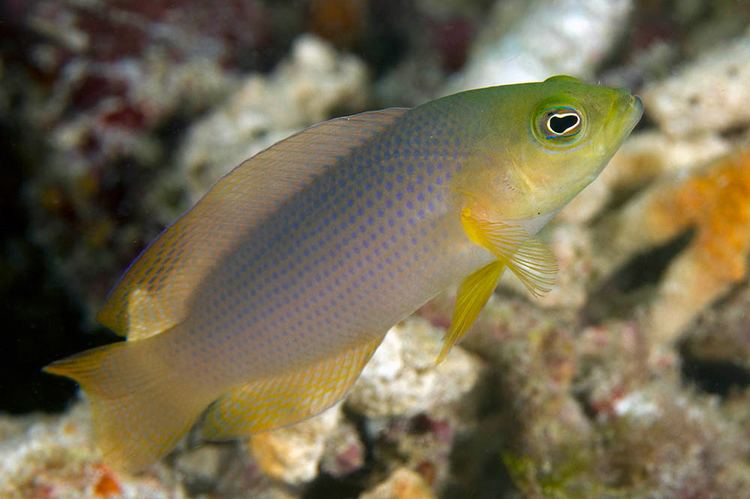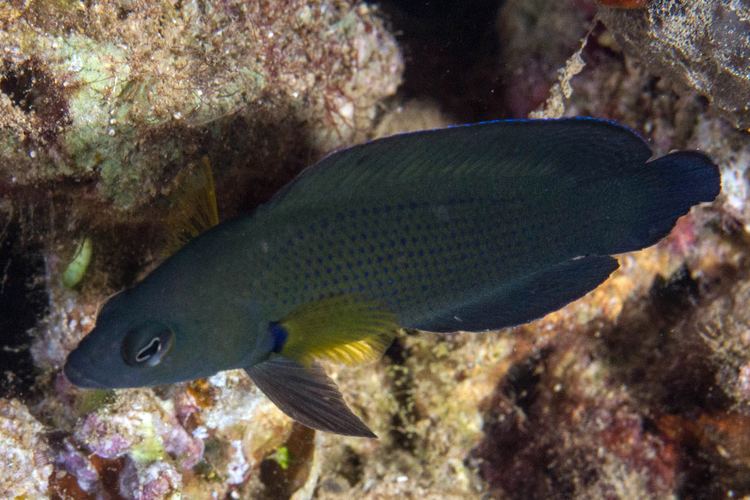Phylum Chordata Rank Species | Family Pseudochromidae Scientific name Pseudochromis fuscus Higher classification Pseudochromis Order Perciformes | |
 | ||
Similar Pseudochromis, Dottyback, Pomacentrus amboinensis, Pseudochromis cyanotaenia, Pictichromis diadema | ||
Yellow dottyback pseudochromis fuscus
Pseudochromis fuscus is a species of saltwater fish in the Dottyback family. Dottybacks are generally very bright in color and relatively small, factors which have made them popular among aquarium enthusiasts. Besides their coloration and size, they are probably best known for their aggressive temperament. While many of the more common dottybacks are in the Pseudochromis genus, there are also species in other genera. Common names for this particular species include the brown dottyback, the golden dottyback, and the musky dottyback. The common name “Golden dottyback” is shared with another species of dottyback, the Pseudochromis pseudoplesiopinae. The species name, fuscus, means dark or dusky in Latin.
Contents
- Yellow dottyback pseudochromis fuscus
- pseudochromis fuscus
- Description
- Taxonomy
- Distribution
- Habitat
- Diet
- Behavior
- Aquaria
- References

pseudochromis fuscus
Description

Brown dottybacks grow to a maximum length of about 10 centimeters and they have three dorsal spines, several dorsal soft rays, three anal spines and a few anal soft rays. The spine count is what distinguishes them from their close neighbor, the true basses from the Serrinadae family. Like most dottybacks, they are very long and slender. They are also the largest species within the Pseudochromis genus. Brown dottybacks have pear-shaped eyes, not unlike bass, and canine teeth. Color usually ranges from bright yellow to dark brown, but orange, pink, and gray fish of this species have been found as well. Blue spots can often be seen on the nape and the anterior part of the body. Studies have shown that the color differences in wild brown dottybacks are not due to genetic changes. In fact, individuals seem to be able to change their color, though the factors causing color changes are undetermined. Interestingly, the shade of yellow or brown that a dottyback displays seems to correlate with the shade of prey that a dottyback targets. For example, Brown dottybacks with a bright yellow coloration are more likely to be found near prey with a bright yellow coloration. Brighter brown dottybacks are also more likely to be found in deeper areas, while their browner cousins are more likely to be found in shallower areas.
Taxonomy
The Pseudochromis fuscus is a member of the Pseudochromidae family, which includes other dottybacks like the purple dottyback (Pseudochromis porphyreus) and the bluelined dottyback (Pseudochromis cyanotaenia). Not all dottybacks are in this family. There are a few in the Anisochromis family too. Pseudochromidae are members of the Percoidei sub-order, which falls under the Perciformes order. This is a very large order that includes many of the bony fish in the ocean. In fact, Perciformes is the largest order of vertebrates, with over 10,000 species. Perciformes is in the Actinopterygii class, which, is in the Pisces superclass. Pisces is in the Chordata phylum, which is in the Animalia kingdom.
Distribution

Pseudochromis fuscus is native to the south-western Pacific Ocean and the eastern Indian Ocean. Its range is from Sri Lanka east to Vanuatu and from Australia north to Hong Kong. A map showing the distribution of this fish can be seen here, with red spots showing the range of this dottyback. As is shown on the map, the southern limit of the distribution stops at about the southern limit of the reefs off the eastern coast of Australia. This is because the brown dottyback is most often found in coral reef habitats.
Habitat
Pseudochromis fuscus is a very common fish on coral reefs. It can make up as much as 10% of the piscivorous fishes in the community, with competing predators consisting of fish like the moon wrasse or lizardfish. The brown dottyback is often found in crevices or ledges. It is also often found swimming near branching corals.
Diet

Pseudochromis fuscus is a carnivorous fish that often feeds on juvenile coral reef fish or crustaceans, though they also will feed on mollusks. Typically, juvenile fish are only targeted for predation during the summer, as the survivors outgrow their vulnerability to dottyback predation by the winter. Common predatory targets include many species of damselfish. Unlike other species of competing piscivors, predation of juvenile fish by the brown dottyback is not affected by the presence of adult males guarding the juveniles. Sometimes, adult male damselfish will guard the nests of their young. While this reduces predation on the young by other predators, predation by dottyback appears to be unaffected. Because of this predatory behavior, the brown dottyback is considered an important regulator of the composition of the coral reef community.
Behavior
The brown dottyback is a very aggressive predatory fish, and therefore, most of the behavioral research conducted on it relates to the predatory relationship that this fish has with others in the coral reef community. Brown dottybacks appear to preferentially prey on fish with longer bodies, an observation which is consistent with the optimal foraging theory. While long body types were preferred in prey, various studies have conflicting results when examining the effects of overall prey size on targeting. Some studies have found that brown dottybacks prefer larger prey, while others have found that smaller prey are preferred. Brown dottybacks also appear to target rare fish for predation more often than common fish. Preference is also given to targeting prey in good condition over prey in bad condition, a distinction that is often made through chemical cues. In fact, it appears as though chemical signals are the primary means by which a foraging response is stimulated. Predatory behavior also increases for brown dottybacks in a bleached coral reef environment, as the lack of coloration of the coral makes it easier for the predators to detect their prey.
Studies have also found that external chemical factors affect brown dottyback behavior. For example, carbon dioxide increases the swimming activity of this fish, while at the same time decreasing the ability of the brown dottyback to sense the chemical signals associated with the presence of prey. However, increasing the carbon dioxide concentration does not necessarily help prey escape, as these changes also decrease the ability the dottyback’s prey to sense the chemical signals of a nearby predator. When an experiment was conducted to study the net effect of increasing carbon dioxide levels on predation of damselfish, the number of smaller fish preyed upon was found to increase under elevated carbon dioxide while the number of larger fish preyed upon was found to be unaffected.
Aquaria
Pseudochromis fuscus, along with many other species in the dottyback family, are often kept as aquarium fish. These fish are as aggressive in captivity as they are in the wild, so brown dottybacks are often kept with fish that will not disturb their territory or they are kept completely separate from other fish. For this reason, it is very important to have only one brown dottyback in a tank. Because this fish is so large relative to other dottybacks, the brown dottyback is even more of a bully than the other aggressive species within the Pseudochromis genus. Still, they are a relatively easy fish to keep in captivity, and they can be kept with larger fish like adult damselfish or parrotfish. It is best to feed brown dottybacks with finely chopped meaty foods, like krill or squid, but this fish will also adapt to eating flakes, pellets, and herbivorous foods. Special attention must be given to the choice of foods, because the brown dottyback’s diet will affect its coloration. This is why a diet high in vitamins is recommended, as this diet should maintain a rich golden color. Another important consideration for a tank containing a brown dottyback is the need for rocky ledges, crevices, and caves.
